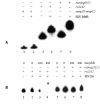Transcriptional analysis of ESAT-6 cluster 3 in Mycobacterium smegmatis
- PMID: 19257911
- PMCID: PMC2660348
- DOI: 10.1186/1471-2180-9-48
Transcriptional analysis of ESAT-6 cluster 3 in Mycobacterium smegmatis
Abstract
Background: The ESAT-6 (early secreted antigenic target, 6 kDa) family collects small mycobacterial proteins secreted by Mycobacterium tuberculosis, particularly in the early phase of growth. There are 23 ESAT-6 family members in M. tuberculosis H37Rv. In a previous work, we identified the Zur- dependent regulation of five proteins of the ESAT-6/CFP-10 family (esxG, esxH, esxQ, esxR, and esxS). esxG and esxH are part of ESAT-6 cluster 3, whose expression was already known to be induced by iron starvation.
Results: In this research, we performed EMSA experiments and transcriptional analysis of ESAT-6 cluster 3 in Mycobacterium smegmatis (msmeg0615-msmeg0625) and M. tuberculosis. In contrast to what we had observed in M. tuberculosis, we found that in M. smegmatis ESAT-6 cluster 3 responds only to iron and not to zinc. In both organisms we identified an internal promoter, a finding which suggests the presence of two transcriptional units and, by consequence, a differential expression of cluster 3 genes. We compared the expression of msmeg0615 and msmeg0620 in different growth and stress conditions by means of relative quantitative PCR. The expression of msmeg0615 and msmeg0620 genes was essentially similar; they appeared to be repressed in most of the tested conditions, with the exception of acid stress (pH 4.2) where msmeg0615 was about 4-fold induced, while msmeg0620 was repressed. Analysis revealed that in acid stress conditions M. tuberculosis rv0282 gene was 3-fold induced too, while rv0287 induction was almost insignificant.
Conclusion: In contrast with what has been reported for M. tuberculosis, our results suggest that in M. smegmatis only IdeR-dependent regulation is retained, while zinc has no effect on gene expression. The role of cluster 3 in M. tuberculosis virulence is still to be defined; however, iron- and zinc-dependent expression strongly suggests that cluster 3 is highly expressed in the infective process, and that the cluster contributes to the antigenic profile during the course of infection. Moreover, cluster 3 induction in acid stress conditions strengthens the hypothesis that cluster 3 is expressed in the course of infection.In M. smegmatis, the expression of msmeg0615 and msmeg0620 genes is broadly similar in differing growth phases and in stress conditions, with the exception of acid stress (pH 4.2). Differences in expression between cluster 3 genes can be explained by the presence of internal promoters, both in M. smegmatis and M. tuberculosis.
Figures






Similar articles
-
Two promoters in the esx-3 gene cluster of Mycobacterium smegmatis respond inversely to different iron concentrations in vitro.BMC Res Notes. 2017 Aug 25;10(1):426. doi: 10.1186/s13104-017-2752-0. BMC Res Notes. 2017. PMID: 28841831 Free PMC article.
-
The ESAT-6 gene cluster of Mycobacterium tuberculosis and other high G+C Gram-positive bacteria.Genome Biol. 2001;2(10):RESEARCH0044. doi: 10.1186/gb-2001-2-10-research0044. Epub 2001 Sep 19. Genome Biol. 2001. PMID: 11597336 Free PMC article.
-
A Mycobacterium tuberculosis operon encoding ESAT-6 and a novel low-molecular-mass culture filtrate protein (CFP-10).Microbiology (Reading). 1998 Nov;144 ( Pt 11):3195-3203. doi: 10.1099/00221287-144-11-3195. Microbiology (Reading). 1998. PMID: 9846755
-
Production of recombinant proteins in Mycobacterium smegmatis for structural and functional studies.Protein Sci. 2015 Jan;24(1):1-10. doi: 10.1002/pro.2584. Epub 2014 Nov 13. Protein Sci. 2015. PMID: 25303009 Free PMC article. Review.
-
Mycobacterium Lrp/AsnC family transcriptional factor modulates the arginase pathway as both a sensor and a transcriptional repressor.J Genet Genomics. 2021 Nov 20;48(11):1020-1031. doi: 10.1016/j.jgg.2021.06.018. Epub 2021 Jul 29. J Genet Genomics. 2021. PMID: 34696992 Review.
Cited by
-
The cell envelope of Mycobacterium abscessus and its role in pathogenesis.PLoS Pathog. 2023 May 18;19(5):e1011318. doi: 10.1371/journal.ppat.1011318. eCollection 2023 May. PLoS Pathog. 2023. PMID: 37200238 Free PMC article. Review.
-
Mycobacterium abscessus Mutants with a Compromised Functional Link between the Type VII ESX-3 System and an Iron Uptake Mechanism Reliant on an Unusual Mycobactin Siderophore.Pathogens. 2022 Aug 23;11(9):953. doi: 10.3390/pathogens11090953. Pathogens. 2022. PMID: 36145386 Free PMC article.
-
A β-Lactamase based reporter system for ESX dependent protein translocation in mycobacteria.PLoS One. 2012;7(4):e35453. doi: 10.1371/journal.pone.0035453. Epub 2012 Apr 18. PLoS One. 2012. Retraction in: PLoS One. 2013;8. doi: 10.1371/annotation/f03f7456-0e04-4c4b-a606-51f262900e8d. PMID: 22530024 Free PMC article. Retracted.
-
To catch a killer. What can mycobacterial models teach us about Mycobacterium tuberculosis pathogenesis?Curr Opin Microbiol. 2010 Feb;13(1):86-92. doi: 10.1016/j.mib.2009.11.006. Epub 2009 Dec 23. Curr Opin Microbiol. 2010. PMID: 20036184 Free PMC article. Review.
-
Architecture of the mycobacterial type VII secretion system.Nature. 2019 Dec;576(7786):321-325. doi: 10.1038/s41586-019-1633-1. Epub 2019 Oct 9. Nature. 2019. PMID: 31597161 Free PMC article.
References
-
- Renshaw PS, Panagiotidou P, Whelan A, Gordon SV, Hewinson RG, Williamson RA, Carr MD. Conclusive evidence that the major T-cell antigens of the Mycobacterium tuberculosis complex ESAT-6 and CFP-10 form a tight, 1:1 complex and characterization of the structural properties of ESAT-6, CFP-10, and the ESAT-6*CFP-10 complex. Implications for pathogenesis and virulence. J Biol Chem. 2002;277(24):21598–21603. doi: 10.1074/jbc.M201625200. - DOI - PubMed
-
- Cole ST, Brosch R, Parkhill J, Garnier T, Churcher C, Harris D, Gordon SV, Eiglmeier K, Gas S, Barry CE 3rd, Tekaia F, Badcock K, Basham D, Brown D, Chillingworth T, Connor R, Davies R, Devlin K, Feltwell T, Gentles S, Hamlin N, Holroyd S, Hornsby T, Jagels K, Krogh A, McLean J, Moule S, Murphy L, Oliver K, Osborne J, Quail MA, Rajandream MA, Rogers J, Rutter S, Seeger K, Skelton J, Squares R, Squares S, Sulston JE, Taylor K, Whitehead S, Barrell BG. Deciphering the biology of Mycobacterium tuberculosis from the complete genome sequence. Nature. 1998;393(6685):537–544. doi: 10.1038/31159. - DOI - PubMed
-
- TubercuList Web Server. http://genolist.pasteur.fr/TubercuList/
Publication types
MeSH terms
Substances
LinkOut - more resources
Full Text Sources
Miscellaneous

